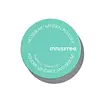What's inside
What's inside
 Key Ingredients
Key Ingredients

 Benefits
Benefits

 Concerns
Concerns

 Ingredients Side-by-side
Ingredients Side-by-side

Silica
AbrasivePolymethyl Methacrylate
Polymethylsilsesquioxane
Boron Nitride
AbsorbentDimethicone
EmollientCaprylic/Capric Triglyceride
MaskingHdi/Trimethylol Hexyllactone Crosspolymer
Methicone
EmollientEthylhexyl Palmitate
EmollientCaprylyl Glycol
EmollientEthylhexylglycerin
Skin ConditioningMacadamia Ternifolia Seed Oil
EmollientHydrogenated Lecithin
EmulsifyingTriethoxycaprylylsilane
Prunus Persica Flower Extract
MoisturisingArnebia Euchroma Root Extract
AntimicrobialNephrite Powder
AbrasiveSilk Powder
Skin ConditioningButylene Glycol
HumectantPearl Powder
Kaolin
AbrasiveTin Oxide
AbrasiveDimethicone/Vinyl Dimethicone Crosspolymer
Skin ConditioningDipropylene Glycol
HumectantPentylene Glycol
Skin ConditioningTocopherol
AntioxidantWater
Skin ConditioningGlycerin
HumectantRibes Nigrum Leaf Extract
PerfumingRubus Idaeus Leaf Extract
Skin ConditioningNymphaea Alba Flower Extract
Skin ConditioningHydroxyacetophenone
AntioxidantSorbic Acid
PreservativeCI 77742
Cosmetic ColorantCI 77891
Cosmetic ColorantSilica, Polymethyl Methacrylate, Polymethylsilsesquioxane, Boron Nitride, Dimethicone, Caprylic/Capric Triglyceride, Hdi/Trimethylol Hexyllactone Crosspolymer, Methicone, Ethylhexyl Palmitate, Caprylyl Glycol, Ethylhexylglycerin, Macadamia Ternifolia Seed Oil, Hydrogenated Lecithin, Triethoxycaprylylsilane, Prunus Persica Flower Extract, Arnebia Euchroma Root Extract, Nephrite Powder, Silk Powder, Butylene Glycol, Pearl Powder, Kaolin, Tin Oxide, Dimethicone/Vinyl Dimethicone Crosspolymer, Dipropylene Glycol, Pentylene Glycol, Tocopherol, Water, Glycerin, Ribes Nigrum Leaf Extract, Rubus Idaeus Leaf Extract, Nymphaea Alba Flower Extract, Hydroxyacetophenone, Sorbic Acid, CI 77742, CI 77891
 Reviews
Reviews

Ingredients Explained
These ingredients are found in both products.
Ingredients higher up in an ingredient list are typically present in a larger amount.
This ingredient is an emollient, solvent, and texture enhancer. It is considered a skin-softener by helping the skin prevent moisture loss.
It helps thicken a product's formula and makes it easier to spread by dissolving clumping compounds.
Caprylic Triglyceride is made by combining glycerin with coconut oil, forming a clear liquid.
While there is an assumption Caprylic Triglyceride can clog pores due to it being derived from coconut oil, there is no research supporting this.
Learn more about Caprylic/Capric TriglycerideDimethicone is a type of synthetic silicone created from natural materials such as quartz.
What it does:
Dimethicone comes in different viscosities:
Depending on the viscosity, dimethicone has different properties.
Ingredients lists don't always show which type is used, so we recommend reaching out to the brand if you have questions about the viscosity.
This ingredient is unlikely to cause irritation because it does not get absorbed into skin. However, people with silicone allergies should be careful about using this ingredient.
Note: Dimethicone may contribute to pilling. This is because it is not oil or water soluble, so pilling may occur when layered with products. When mixed with heavy oils in a formula, the outcome is also quite greasy.
Learn more about DimethiconeThis ingredient is a silicone used to improve the texture of products and absorb oil. It does not get absorbed into the skin.
Like other silicones, Dimethicone/Vinyl Dimethicone Crosspolymer helps condition the skin by creating a barrier. In this sense, it can act as an emollient and trap moisture in.
This ingredient is a type of elastomer.
Learn more about Dimethicone/Vinyl Dimethicone CrosspolymerEthylhexylglycerin (we can't pronounce this either) is commonly used as a preservative and skin softener. It is derived from glyceryl.
You might see Ethylhexylglycerin often paired with other preservatives such as phenoxyethanol. Ethylhexylglycerin has been found to increase the effectiveness of these other preservatives.
Methicone is a type of silicone and is a simpler form of dimethicone.
Silicones are used to enhance the texture of products and have emollient properties. Methicone is used to give products a silky texture and improves spreadability.
Silica, also known as silicon dioxide, is a naturally occurring mineral. It is used as a fine, spherical, and porous powder in cosmetics.
Though it has exfoliant properties, the function of silica varies depending on the product.
The unique structure of silica enhances the spreadability and adds smoothness, making it a great texture enhancer.
It is also used as an active carrier, emulsifier, and mattifier due to its ability to absorb excess oil.
In some products, tiny microneedles called spicules are made from silica or hydrolyzed sponge. When you rub them in, they lightly polish away dead skin layers and enhance the penetration of active ingredients.
Learn more about SilicaTocopherol (also known as Vitamin E) is a common antioxidant used to help protect the skin from free-radicals and strengthen the skin barrier. It's also fat soluble - this means our skin is great at absorbing it.
Vitamin E also helps keep your natural skin lipids healthy. Your lipid skin barrier naturally consists of lipids, ceramides, and fatty acids. Vitamin E offers extra protection for your skin’s lipid barrier, keeping your skin healthy and nourished.
Another benefit is a bit of UV protection. Vitamin E helps reduce the damage caused by UVB rays. (It should not replace your sunscreen). Combining it with Vitamin C can decrease sunburned cells and hyperpigmentation after UV exposure.
You might have noticed Vitamin E + C often paired together. This is because it is great at stabilizing Vitamin C. Using the two together helps increase the effectiveness of both ingredients.
There are often claims that Vitamin E can reduce/prevent scarring, but these claims haven't been confirmed by scientific research.
Learn more about Tocopherol